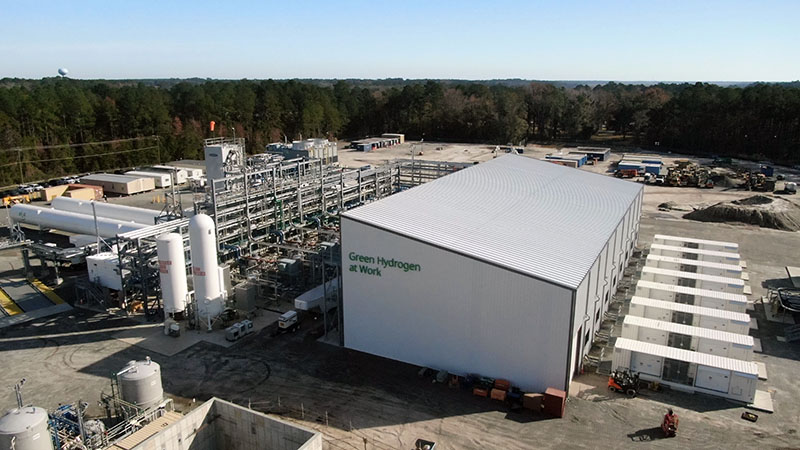The Rise of Green Hydrogen: Stats, Trends, and Future Projections

Green hydrogen is emerging as a game-changer in the quest for clean energy solutions. It is seen as a crucial element in reducing carbon emissions and helping the world transition to more sustainable energy sources. But what exactly is green hydrogen? Let’s take a look at the green hydrogen market.
Green hydrogen is produced by splitting water into hydrogen and oxygen using electricity generated from renewable sources like wind or solar power. This process, called electrolysis, results in hydrogen that is free from carbon emissions, hence the name “green hydrogen.”
The concept of hydrogen as an energy source isn’t new. In fact, it has been around for decades. However, the increasing focus on climate change and the urgent need to reduce greenhouse gas emissions have put green hydrogen back in the spotlight. Countries and companies worldwide are now investing heavily in green hydrogen technologies and infrastructure, recognizing its potential to revolutionize the energy landscape.
The importance of green hydrogen cannot be overstated. Unlike traditional fossil fuels, green hydrogen combusts cleanly, reducing NOx by >90% over fossil fuel combustion, and producing primarily water vapor as a byproduct. This makes it an ideal candidate for replacing fossil fuels in various applications, from transportation to industrial processes. Unlike with fossil fuels, there is no CO or CO2 emitted when green hydrogen is combusted. It can also be used as fuel for a fuel cell product, where it combines electrochemically with oxygen from the air to provide emission-free electricity that can be used in vehicles, generators, and other products.
In this blog, we will explore the current state of the green hydrogen market, the technologies driving its growth, the regions leading its adoption, and the challenges and prospects of this promising energy solution.
Industry Applications
Green hydrogen is increasingly recognized for its versatility and potential to decarbonize various sectors. Here are eight key applications where green hydrogen is making a significant impact (Plug Power):
- Transportation: Green hydrogen is used to power fuel cell electric vehicles (FCEVs), including buses, trucks, trains, and even ships. These vehicles emit only water vapor, providing a clean alternative to fossil fuels. Cities in Europe and North America are adopting hydrogen-powered buses to reduce urban pollution and greenhouse gas emissions. Plug is at the forefront of deploying hydrogen-powered forklifts in warehouses, further showcasing its utility in the logistics sector.

- Aviation: The aviation industry is exploring hydrogen as a key component for sustainable aviation fuels (SAFs). Hydrogen can be combined with captured CO2 to produce synthetic fuels, significantly reducing the carbon footprint of air travel. Companies like Airbus are developing hydrogen-powered aircraft, aiming to revolutionize the aviation sector by cutting down emissions.
- Industrial Processes: Green hydrogen is crucial in decarbonizing industrial processes, particularly in steel manufacturing. The Direct Reduced Iron (DRI) process uses hydrogen as a reducing agent to convert iron ore into steel, significantly lowering carbon emissions compared to traditional methods. Hydrogen is also being used in chemical production, including green ammonia and methanol, which are essential for fertilizers and other industrial applications.
- Energy Storage and Grid Balancing: Green hydrogen plays a vital role in energy storage, helping to balance the grid by storing excess renewable energy generated during periods of low demand and releasing it when demand is high. This capability is essential for integrating renewable energy sources like wind and solar into the energy grid, ensuring a stable and reliable power supply.
- Power Generation: Hydrogen can be used directly in fuel cells to generate electricity, providing a clean and efficient power source. This application is particularly useful in remote or off-grid locations where traditional power infrastructure is lacking. Fuel cells powered by hydrogen are being used to provide electricity and heat for residential and commercial buildings, as well as backup power for critical facilities.
- Heating: Green hydrogen can be used for heating applications in residential, commercial, and industrial settings. Hydrogen-powered boilers and heaters offer a low-carbon alternative to natural gas, helping to reduce emissions from heating systems. This application is especially relevant in countries with cold climates where heating demand is high.
- Synthetic Fuels Production: Hydrogen is a key ingredient in the production of synthetic fuels, which can be used in various applications, including transportation and industrial processes. By combining hydrogen with captured CO2, synthetic fuels can provide a carbon-neutral alternative to conventional fossil fuels, supporting the transition to a sustainable energy future.
- Maritime Transport: Hydrogen is being utilized in small scale demonstrations to power ships, and it is hoped hydrogen will provide a sustainable alternative to the heavy fuel oils traditionally used in the maritime industry. E-fuels like e-methanol and e-ammonia, which are produced using green hydrogen, are gaining traction as cleaner fuels for shipping.
These applications highlight the transformative potential of green hydrogen across multiple sectors. By replacing traditional fuels with clean hydrogen, industries can significantly reduce their carbon footprint and contribute to global decarbonization efforts.
Technological Advancements
The green hydrogen industry is rapidly evolving, with several significant technological advancements that are making production more efficient and cost-effective. These innovations are essential for scaling up green hydrogen to meet global energy demands and reduce carbon emissions.
One of the latest breakthroughs comes from researchers at the Ulsan National Institute of Science and Technology (UNIST) who have developed scalable and efficient photoelectrode modules for green hydrogen production. These modules use sunlight to directly split water into hydrogen and oxygen, offering a promising approach to making green hydrogen production more competitive and accessible (ScienceDaily).
Another innovative technique has been introduced by researchers from the Technion – Israel Institute of Technology. They developed a novel electrolysis process called E-TAC (electrochemical and thermally activated chemical). Unlike traditional electrolysis, which requires membranes to separate hydrogen and oxygen, the E-TAC process produces these gases at different stages, thereby eliminating the need for membranes and reducing complexity and costs. This method significantly enhances the efficiency and scalability of hydrogen production (Tech Xplore).
In the commercial sector, companies like Plug are leading the way with substantial advancements. Plug has developed new products such as hydrogen storage tanks and a mobile liquid hydrogen refueler, which are crucial for enhancing the infrastructure needed for widespread hydrogen adoption. Additionally, the company is working on large-scale electrolyzer projects, aiming to boost green hydrogen production capacity significantly (Plug Power).

As we move through 2024, the global perspective on green hydrogen remains optimistic. According to Rystad Energy, this year is expected to see a surge in green hydrogen projects, especially in regions like Australia, the Middle East, and Africa. These regions are benefiting from maturing policies and early commercial-scale projects that are setting the stage for broader adoption and integration of green hydrogen technologies (Green Hydrogen News).
By improving efficiency, reducing costs, and expanding infrastructure, green hydrogen can play a crucial role in achieving global decarbonization goals and supporting a sustainable energy transition.
Current Green Hydrogen Market Overview
Green hydrogen is emerging as a vital solution for decarbonizing several major industries, including heavy-duty mobility, ammonia production, and steel manufacturing. By offering a clean, sustainable alternative to fossil fuels, green hydrogen is playing a crucial role in the global push towards reducing carbon emissions and achieving sustainability goals.
Decarbonizing Major Industries:
- Heavy-Duty Mobility: Green hydrogen is increasingly being used to power heavy-duty vehicles, such as buses, trucks, and trains. Hydrogen fuel cells provide a zero-emission alternative to diesel engines, which are significant contributors to air pollution and greenhouse gas emissions. Cities in Europe and North America are adopting hydrogen fuel cell-powered public transportation to reduce urban pollution and improve air quality (World Economic Forum).
- Ammonia Production: The chemical industry, particularly ammonia production, is another major sector benefiting from green hydrogen. Traditional ammonia production processes are highly carbon-intensive, but using green hydrogen can significantly reduce emissions. Green ammonia is produced using hydrogen derived from renewable energy sources, which helps in reducing the overall carbon footprint of the chemical industry (McKinsey).
- Steel Manufacturing: In the steel industry, hydrogen is being utilized in the Direct Reduced Iron (DRI) process, which replaces carbon-intensive methods with hydrogen as the reducing agent. This shift can significantly cut carbon emissions associated with steel production, making it a cleaner alternative. Several leading steel manufacturers are investing in hydrogen-based DRI processes to meet their decarbonization targets (IEA).
Green Hydrogen Market Size and Growth:
The global green hydrogen market is experiencing substantial growth. As of 2024, the market size exceeded USD 6.49 billion, and it is projected to grow at a compound annual growth rate (CAGR) of over 31% from 2024 to 2032. By 2030, the global green hydrogen deployment is expected to reach 150 GW – approximately 63,750 tons per day. This growth is driven by stringent emission norms, increasing investments in renewable energy infrastructure, and the rising demand for clean energy alternatives (Global Market Insights, Expert Market Research).
Key Drivers:
- Technological Advancements: Advancements in electrolyzer technologies, such as Proton Exchange Membrane (PEM) and Solid Oxide Electrolyzers, are enhancing efficiency and reducing the costs of hydrogen production. Innovations in catalysts, membrane materials, and system designs are also contributing to these improvements (Data Bridge Market Research).
- Government Support: Governments worldwide are introducing policies and incentives to support the development and adoption of green hydrogen. For instance, the U.S. government’s Inflation Reduction Act, which includes the Clean Hydrogen Production Tax Credit, is expected to drive significant investments in the hydrogen economy. Similarly, the European Union has ambitious targets to produce 10 million tonnes of renewable hydrogen by 2030 (Markets and Markets).
- Public and Private Investments: Major companies, including Siemens Energy, Air Liquide, and Plug, are investing heavily in green hydrogen technologies and infrastructure. These investments are crucial for scaling up production and making green hydrogen more competitive with fossil fuels (Data Bridge Market Research).
By decarbonizing key industries and leveraging technological advancements, green hydrogen is poised to play a pivotal role in the transition to a sustainable energy future.
Growth Drivers
The rapid expansion of the green hydrogen market is propelled by several key drivers, including global decarbonization goals, technological advancements, and substantial investments from both public and private sectors. These factors are crucial in scaling up green hydrogen production and making it a cornerstone of the future energy landscape.
Global Decarbonization Goals: One of the primary drivers of the green hydrogen market is the global push towards decarbonization. Nations around the world are setting ambitious targets to reduce carbon emissions and transition to sustainable energy sources. Green hydrogen, produced using renewable energy, offers a viable solution to replace fossil fuels in various applications, thus significantly reducing greenhouse gas emissions (Global Market Insights).
Technological Advancements: Advances in hydrogen production technologies are enhancing efficiency and reducing costs. Proton Exchange Membrane (PEM), Solid Oxide, and Alkaline Electrolyzers are making green hydrogen production more viable. Alkaline electrolyzers are noted for their durability and cost-effectiveness, making them a competitive option for large-scale hydrogen production which remains a widely used method due to its reliability and lower operational costs (Data Bridge Market Research).
Increased Investments: Both public and private sectors are investing heavily in the development of green hydrogen technologies and infrastructure. Governments are introducing incentives, funding programs, and regulatory frameworks to support green hydrogen projects. For instance, the U.S. government’s Inflation Reduction Act (IRA), which included a Clean Hydrogen Production Tax Credit, is expected to drive significant investments in the hydrogen economy. These policies provide financial support and tax incentives for hydrogen production and infrastructure development (Markets and Markets).
Government and Corporate Initiatives: Specific initiatives by governments and corporations are boosting the green hydrogen sector. In Europe, substantial investments are being made to develop hydrogen infrastructure and production capabilities. The European Union aims to produce 10 million tonnes of renewable hydrogen by 2030, supported by policies and funding. Corporate partnerships, such as those between Air Liquide and automotive giants for hydrogen mobility solutions, are also playing a crucial role. These collaborations are focused on developing hydrogen-powered vehicles and the necessary refueling infrastructure (Global Market Insights). For more detailed information on global green hydrogen policy incentives, you can refer to “A Deep Dive into Global Green Hydrogen Policy Incentives”, published by Plug in 2023.
45V and the Inflation Reduction Act (IRA): The 45V tax credit, part of the U.S. Inflation Reduction Act, is a significant driver for green hydrogen projects. It provides tax credits for hydrogen production based on the carbon intensity of the hydrogen produced. This incentive is designed to make green hydrogen more competitive with traditional hydrogen production methods, thereby encouraging investment and scaling up production. The IRA also includes provisions for renewable energy generation, which further supports the green hydrogen market by ensuring a steady supply of renewable electricity for hydrogen production (Markets and Markets).
By leveraging technological advancements, increasing investments, and supporting initiatives, the green hydrogen market is set to expand rapidly, paving the way for a cleaner and more sustainable energy future.
Regional Insights
The global green hydrogen market is experiencing varied growth patterns across different regions, driven by unique factors and regional policies.

Europe: Europe continues to lead the global green hydrogen market, driven by ambitious policy frameworks and substantial investments in hydrogen infrastructure. The European Union aims to produce 10 million tonnes of renewable hydrogen by 2030. Major investments and projects, such as the development of hydrogen hubs and large-scale electrolysis plants, are underway. European initiatives like the 2050 Low Carbon Strategy and the Green Pact for Europe emphasize hydrogen’s role in decarbonizing the energy sector, particularly in hard-to-abate industries such as steel and chemicals (Global Market Insights).
North America: In North America, the United States is seeing significant advancements thanks to supportive policies like the Inflation Reduction Act (IRA) and the Clean Hydrogen Investment Tax Credit. These policies provide financial incentives for hydrogen production and infrastructure development, positioning the U.S. as a major player in the green hydrogen market. The region is expected to play a critical role as a hydrogen exporter (Hydrogen Council, Markets and Markets).
Asia-Pacific: The Asia-Pacific region is experiencing rapid growth in green hydrogen projects, particularly in countries like China, Japan, India, and Australia. China is investing heavily in hydrogen infrastructure, with plans to build extensive hydrogen pipelines and production facilities. Japan continues to support hydrogen through initiatives such as contracts for difference (CfD) to encourage the development of green hydrogen technologies. Australia is leveraging its abundant renewable resources to become a key player in the global hydrogen supply chain, with several large-scale projects underway. India is also emerging as a significant player, with government initiatives aimed at promoting hydrogen as a clean energy source. India’s National Hydrogen Mission aims to make the country a green hydrogen hub by investing in production technologies and infrastructure (McKinsey, Data Bridge Market Research, Markets and Markets).
Middle East and North Africa (MENA): The MENA region, particularly the Gulf Cooperation Council (GCC) states, is emerging as a significant player in green hydrogen production due to its vast renewable energy resources. The United Arab Emirates (UAE), with the lowest solar power costs globally, is well-positioned to develop large-scale green hydrogen projects. Saudi Arabia and Oman are also investing in hydrogen production facilities aimed at both domestic use and export markets (GlobeNewswire).
Challenges and Opportunities: Despite the promising growth, the green hydrogen market faces challenges such as high production costs, limited infrastructure for storage and distribution, and regulatory uncertainties. However, international collaborations and technological advancements are helping to overcome these barriers. Partnerships between countries are facilitating knowledge exchange, technology transfer, and joint research initiatives, which are essential for scaling up hydrogen production and reducing costs (Hydrogen Council, Data Bridge Market Research).
Challenges and Barriers
The growth of the green hydrogen market is promising, but several significant challenges need to be addressed to accelerate its expansion and make it more competitive with traditional energy sources.
High Initial Costs: One of the most substantial barriers to the widespread adoption of green hydrogen is the high initial costs associated with its production, conversion, storage, and transportation. The cost of producing green hydrogen using electrolyzers remains high due to the expensive materials and technology required. This rise is driven by higher capital expenditure (capex) for electrolyzer systems, increased costs for the balance of plant (BoP), and engineering, procurement, and construction (EPC) (McKinsey).
Scalability Issues: Scaling up green hydrogen production to meet global demand poses significant challenges. The current production capacity is insufficient to support large-scale industrial applications. Increasing the scale of production requires substantial investments in new infrastructure, including large electrolyzer plants and renewable energy sources. The deployment of green hydrogen technology needs to be accelerated to meet future demand, but this requires overcoming technical and financial hurdles (McKinsey).
Infrastructure Needs: Developing the necessary infrastructure for green hydrogen is another critical challenge. This includes pipelines, storage facilities, and refueling stations. Without a robust network, the efficient transportation and delivery of green hydrogen remain hindered. The lack of infrastructure limits the accessibility and availability of green hydrogen, inhibiting its widespread adoption across various sectors such as transportation, industry, and energy storage (McKinsey).
Regulatory and Policy Uncertainty: Another major barrier is the lack of clarity around regulatory incentives, such as the 45V tax credit under the U.S. Inflation Reduction Act (IRA). While these incentives are designed to make green hydrogen more competitive, the details and implementation of such policies remain unclear, causing uncertainty for investors and developers. Clear and consistent policies are crucial to encourage investment and provide a stable framework for the development of green hydrogen projects (McKinsey).
Public Perception and Awareness: Negative perceptions or lack of understanding about hydrogen technologies can hinder acceptance and adoption. Misconceptions about safety, reliability, and environmental benefits may lead to reluctance from consumers, investors, and policymakers. This can slow down market growth and investment, delaying the transition to a hydrogen-based economy (McKinsey).
These challenges highlight the need for coordinated efforts between governments, industries, and research institutions to address these barriers. By improving cost efficiency, scaling up production, developing infrastructure, and providing clear regulatory frameworks, the green hydrogen market can overcome these obstacles and achieve its full potential as a cornerstone of the global energy transition.
Future Projections
The green hydrogen market is poised for significant growth, driven by technological advancements and increased investment. According to the latest McKinsey report, the market is expected to expand rapidly over the next decade, with substantial improvements in production capacity and cost efficiency.
Market Expansion and Technological Improvements: The global green hydrogen market is projected to reach 150 GW of production capacity by 2030. Continuous technological advancements in electrolyzer efficiency are critical to this expansion. Innovations in Proton Exchange Membrane (PEM) and Solid Oxide Electrolyzers are expected to lower production costs and enhance output, making green hydrogen more competitive with traditional energy sources. These improvements will be pivotal in reducing the levelized cost of hydrogen (LCOH) (McKinsey).
Widespread Adoption Across Sectors: As costs decrease and production capacity increases, green hydrogen is expected to be adopted widely across various sectors:
- Transportation: Green hydrogen will fuel heavy-duty vehicles, buses, and trains, providing a zero-emission alternative to diesel and gasoline.
- Industrial Processes: Green hydrogen will replace carbon-intensive processes in industries such as steel manufacturing, ammonia production, and chemical processing.
- Energy Storage: Green hydrogen will play a crucial role in energy storage and grid stabilization, balancing supply and demand in renewable energy systems.
Global Energy Strategies: Green hydrogen is set to become a cornerstone of global energy strategies, significantly contributing to decarbonization efforts. Governments and industries worldwide are recognizing its potential to meet climate targets and reduce fossil fuel dependence. Policy support, such as production tax credits and mandates for renewable hydrogen, will drive this transition. For example, the U.S. government’s Inflation Reduction Act (IRA) included a Clean Hydrogen Production Tax Credit that is expected to drive significant investments in the hydrogen economy (McKinsey).
These projections highlight the transformative potential of green hydrogen. With continued technological advancements and supportive policies, green hydrogen is positioned to play a pivotal role in the global energy landscape, driving both economic growth and environmental sustainability.
Conclusion
Green hydrogen is emerging as a transformative solution in the quest for clean energy and decarbonization. Its potential to replace fossil fuels across various sectors such as transportation, industry, and energy storage, positions it as a critical component of global sustainability strategies. The significant growth projections for the green hydrogen market underscore its importance, driven by technological advancements and supportive policies.

Despite the challenges of high initial costs, scalability issues, and infrastructure needs, the future of green hydrogen looks promising. Technological improvements, particularly in electrolyzer efficiency, are expected to lower production costs and enhance hydrogen output, making it increasingly competitive with traditional energy sources. These advancements are crucial for achieving widespread adoption and integrating green hydrogen into the global energy mix.
Government initiatives and corporate partnerships are vital in accelerating the development and deployment of green hydrogen technologies. Policies such as the U.S. Inflation Reduction Act (IRA) and the European Union’s hydrogen strategies are providing the necessary financial incentives and regulatory frameworks to support this transition. Additionally, international collaborations and investments are fostering knowledge exchange and driving down costs, further boosting the market’s growth.
As green hydrogen continues to evolve, its role in decarbonizing hard-to-abate sectors and supporting a clean and resilient energy system becomes increasingly clear. With coordinated efforts from governments, industries, and research institutions, green hydrogen can overcome existing barriers and achieve its full potential as a cornerstone of the global energy transition.
In summary, the path forward for green hydrogen is bright. By leveraging technological advancements, increasing investments, and supporting initiatives, we can pave the way for a cleaner, more sustainable future powered by green hydrogen.






